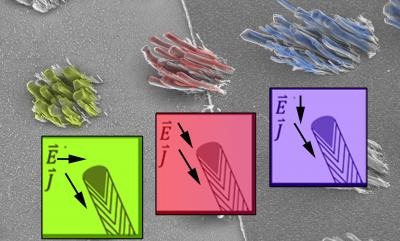North Carolina State University researchers have identified a novel technique to grow straight carbon nanofibers atop a transparent substrate.
 "Carbon nanofibers at the interface between non-conductive (left) and conductive (right) substrates do not align with the electrical field (E), but rather orient along the ion flux lines. Controlling the direction of the ion flux provides the means to grow oriented nanofibers even on insulating materials, thereby greatly extending the application space for this important nanoscale material."
"Carbon nanofibers at the interface between non-conductive (left) and conductive (right) substrates do not align with the electrical field (E), but rather orient along the ion flux lines. Controlling the direction of the ion flux provides the means to grow oriented nanofibers even on insulating materials, thereby greatly extending the application space for this important nanoscale material."
The formation of these nanofiber coatings is important for applications in water repellent coatings, solar cells, biomedical research tools, and many others. The technique uses a grid made of charged chromium and with the help of ions ensures that the developed nanofibers do not get curled. Curling of the nanofibers will hinder its usage.
In particular, genetic material can be coated on the nanofibers and introduced into the cell’s nucleus, for instance, to enhance the research of gene therapy. Scientists can pass light through the transparent substrate, which results in better contrast and better visibility of the process taking place.
The nanofibers are created by dispersing nickel nanoparticles consistently on a fused silicon substrate. This substrate is covered with a fine chromium grid which acts as an electrode. The set up is then kept in a chamber at 700°C, and later filled with ammonia and acetylene gas. The chromium grid acts as a negatively charged electrode, and the upper part of the chamber comprises a positively charged electrode.
The ammonia, acetylene and gas atoms get excited on applying electric voltage to the two electrodes. Few electrons present in these atoms split into positively charged ions and free electrons. These ions move towards the bottom of the chamber containing the negatively charged grid. In the mean time, nickel nanoparticles that act as catalysts react with the carbon present in acetylene gas creating graphitic carbon nanofibers, where the carbon atoms are arranged in the form of a hexagon.
The major problem in further growth of nanofibers is that the catalyst surface gets blocked by a carbon film. Thus ions play a key role in solving it. The rapidly moving ions opt for the easiest path to reach the negatively charged chromium grid. This rush causes the collision of the ions with the nickel catalysts, thereby knocking down excessive carbon enabling further growth of nanofibers.